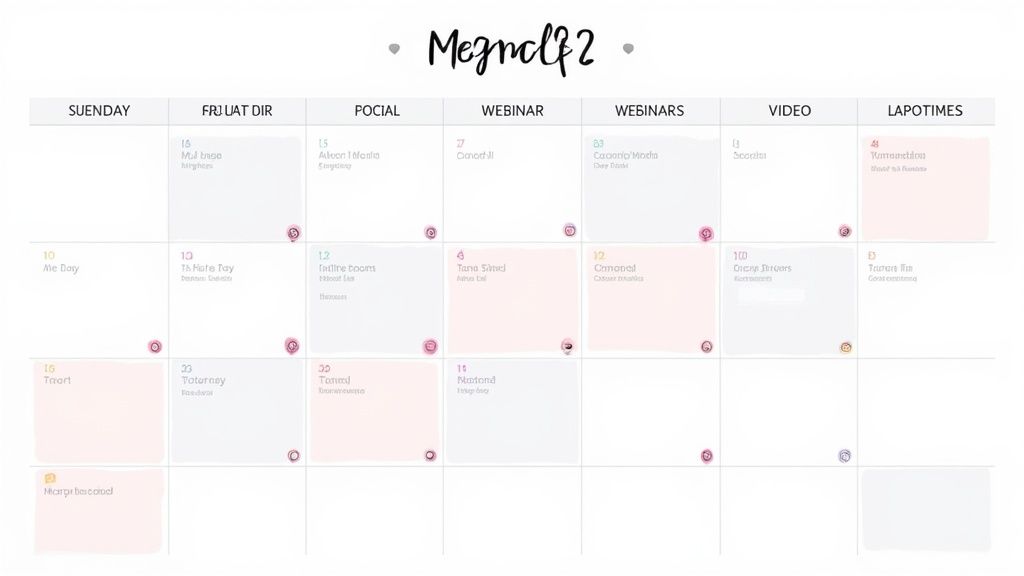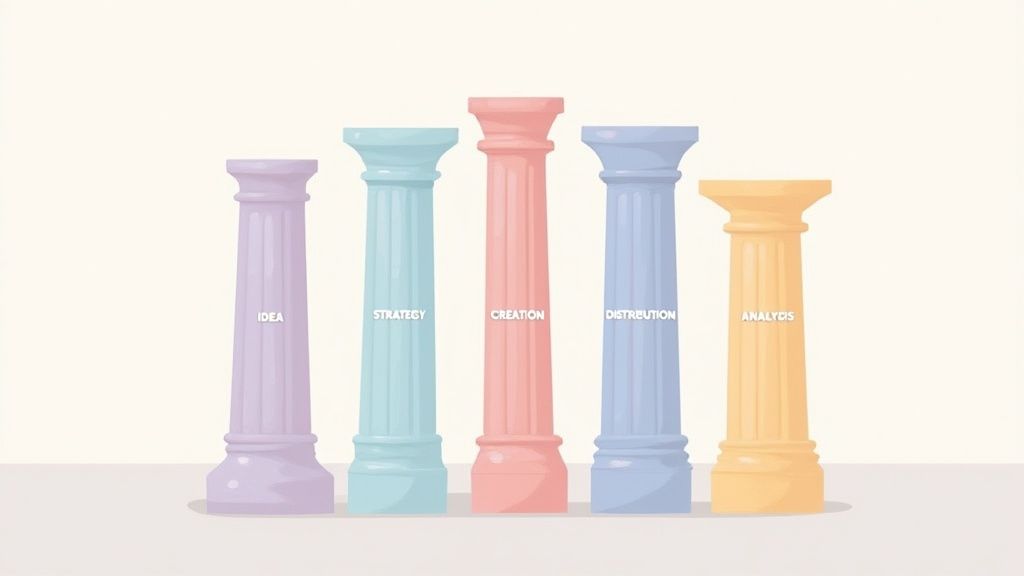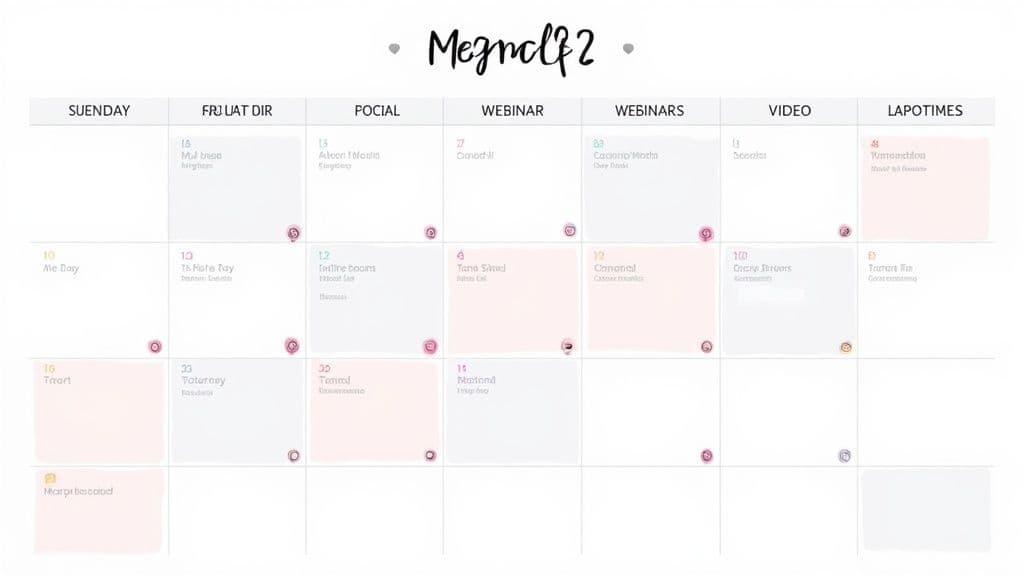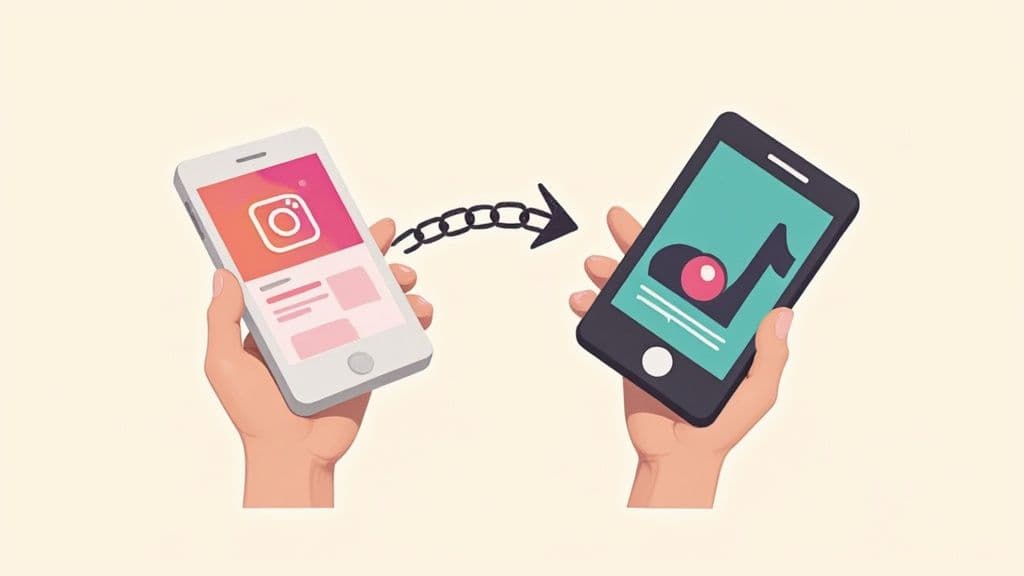In the fast-paced world of social media, simply creating content isn't enough. Without a solid plan, even the best ideas can get lost in the noise, leading to inconsistent posting, burnout, and missed opportunities. Many creators and businesses face the same frustrating cycle: a frantic search for what to post today, followed by a period of silence, and then another burst of unstructured activity. This reactive approach rarely builds momentum or achieves meaningful goals.
The key to sustainable growth and genuine audience engagement lies in effective content planning strategies. These frameworks are more than just schedules; they are blueprints that transform random acts of content into a cohesive, goal-driven machine. A well-executed plan ensures every post has a purpose, speaks directly to your audience, and contributes to your larger objectives, whether that's brand awareness, lead generation, or community building.
This guide breaks down eight proven content planning strategies designed to bring order to your social media chaos. We'll move beyond generic advice and provide actionable steps for implementing each one. You will learn how to build an editorial calendar, define content pillars, put your audience first, and strategically repurpose your best work. We'll also cover how a powerful tool like Postiz can streamline the entire process, from ideation to analysis. It's time to stop guessing and start planning. Let's build a content strategy that delivers real, measurable results.
1. Strategy 1: Master Your Schedule with an Editorial Calendar
An editorial calendar is more than just a schedule; it's a strategic command center for your entire content operation. This comprehensive planning system maps out every piece of content you'll create and publish, from social media updates and blog posts to videos and newsletters. It provides a crucial bird's-eye view, ensuring your messaging stays consistent and your timing is optimized for maximum impact. Think of it as the ultimate blueprint for your content planning strategies, turning chaotic ideas into a coordinated, effective campaign.

This approach is particularly powerful for businesses aiming for long-term growth and brand consistency. For example, a company like HubSpot uses an extensive editorial calendar to coordinate its global content marketing, aligning blog articles, webinars, and social media promotions months in advance. Similarly, Netflix builds immense anticipation by mapping its content marketing around show release dates, creating a unified promotional blitz across all channels.
How to Implement This Strategy
To make an editorial calendar work for you, focus on detailed organization and forward-thinking. Your calendar should be a living document that guides daily tasks while keeping long-term goals in sight.
- Color-Code Everything: Assign distinct colors to different content types (e.g., blog post, video, promotion), platforms (e.g., Instagram, TikTok, LinkedIn), and campaign stages (e.g., drafting, scheduled, published). This visual system makes it easy to see your content mix at a glance.
- Include Promotion Details: Don’t just schedule the publication date. Add specific tasks for promoting the content, such as scheduling five promotional tweets, creating an Instagram Story, or sharing it in a relevant Facebook group.
- Build in Flexibility: A rigid calendar can stifle creativity and prevent you from reacting to trending topics. Leave about 20% of your schedule open for spontaneous or reactive content. This gives you the structure you need without sacrificing agility.
- Set Automated Reminders: Use your calendar tool or a platform like Postiz to set up automatic reminders for content creation deadlines, review cycles, and publishing dates. This prevents tasks from falling through the cracks.
Key Insight: An effective editorial calendar doesn't just list what to post and when. It connects each piece of content to a larger strategic goal, ensuring every post has a clear purpose.
This method is ideal when you need to manage multiple content creators, align different marketing channels, or plan large-scale campaigns around specific events or holidays. It brings order to complexity, making it an indispensable tool for any serious content creator or business. To get started quickly, you can use our comprehensive guide and downloadable template. Find out more about building your own content calendar on Postiz.com.
2. Content Pillar Strategy
A content pillar strategy is a foundational approach that organizes your entire content universe around a few core themes. These pillars, typically 3 to 5 key topics, are directly aligned with your brand values, audience interests, and business objectives. Each pillar acts as a central hub from which all your smaller content pieces, like social media posts, stories, and reels, are derived. This method is one of the most effective content planning strategies for building authority and ensuring your messaging remains focused and consistent.

This approach helps establish you as an expert in your niche. For example, Patagonia builds its content around pillars like Environmental Activism, Outdoor Adventure, and Product Innovation, reinforcing its brand identity with every post. Similarly, Mailchimp focuses its content pillars on Marketing Tips, Small Business Stories, and Design Inspiration, directly serving its target audience's needs and positioning itself as a helpful resource.
How to Implement This Strategy
To successfully implement a content pillar strategy, you need to be intentional about your core topics and how you atomize them into smaller pieces of content. This keeps your feed diverse yet thematically unified.
- Define Your Pillars: Select 3-5 broad topics that intersect your expertise with your audience's pain points. A fitness coach might choose pillars like "At-Home Workouts," "Nutritional Guidance," and "Mindset & Motivation."
- Create Sub-Themes: Break down each pillar into smaller, more specific sub-topics. For "Nutritional Guidance," sub-themes could be "meal prep ideas," "understanding macros," and "healthy snack swaps." This prevents your content from becoming repetitive.
- Develop Unique Formats: Assign different content formats to your pillars to keep your audience engaged. For example, use Reels for "At-Home Workouts," Carousels for "Nutritional Guidance," and text-based posts for "Mindset & Motivation."
- Maintain a Content Mix: Aim for a balanced approach to your pillar content. A good rule of thumb is the 60-30-10 ratio: 60% educational content, 30% inspirational or entertaining content, and 10% promotional content.
Key Insight: Content pillars transform your content plan from a random collection of posts into a structured, interconnected ecosystem that consistently delivers value and reinforces your brand's expertise.
This method is perfect for brands and creators who want to build a strong, recognizable identity and become a go-to resource in their field. It simplifies brainstorming and ensures every piece of content you create has a clear purpose tied to your overarching goals. You can manage your content pillars and schedule related posts efficiently using Postiz’s planning features.
3. Audience-First Planning
Audience-first planning flips the traditional content creation model on its head. Instead of starting with what you want to say, this strategy begins with a deep understanding of who your audience is, what they need, and how they behave. It involves creating detailed audience personas and segments, then crafting content specifically to address their pain points and preferences at every stage of their journey. This is one of the most effective content planning strategies for building a loyal community and driving meaningful engagement.

This approach is championed by brands that excel at creating personal connections. For instance, Spotify's entire platform is built on audience-first principles, with personalized playlists like "Discover Weekly" using user data to deliver highly relevant content. Similarly, Sephora creates beauty tutorials and guides tailored to different customer skill levels and interests, from beginners to experts, ensuring everyone feels seen and supported.
How to Implement This Strategy
To successfully adopt an audience-first approach, you must make audience research an ongoing process, not a one-time task. Your goal is to move from broad assumptions to data-backed insights that inform every piece of content you create.
- Create Detailed Personas: Go beyond basic demographics. Develop rich personas that include goals, challenges, preferred social media platforms, and content consumption habits. Give each persona a name and story to make them relatable for your team.
- Use Analytics to Find Patterns: Dive into your social media and website analytics. Identify which topics, formats, and post times generate the most engagement from specific audience segments. Use this data to double down on what works.
- Monitor Audience Feedback: Actively listen to comments, direct messages, and brand mentions. This qualitative feedback is a goldmine for understanding your audience's language, pressing questions, and current sentiments.
- Test Content Before Full Rollout: Before investing heavily in a new content direction, test it with a small segment of your audience or an internal focus group. Use their feedback to refine your approach for maximum impact.
Key Insight: Audience-first planning ensures your content acts as a service to your audience, not just a promotion for your brand. It shifts the focus from "what can we sell?" to "how can we help?"
This method is ideal for brands looking to build lasting relationships and differentiate themselves in a crowded market. It guarantees relevance and value, making your content a destination rather than an interruption. Tools like Postiz can help you tag content by persona, allowing you to track performance and ensure a balanced content mix for all your key audience segments.
4. Repurposing and Content Atomization
Repurposing content, often called content atomization, is a resource-efficient strategy that multiplies the value of your work. It involves creating one large, comprehensive piece of content and then systematically breaking it down into smaller, bite-sized pieces. These smaller assets are then optimized for different platforms and formats, ensuring your message reaches a wider audience without reinventing the wheel every time. This approach is one of the most powerful content planning strategies for maximizing reach and maintaining message consistency across all your channels.

This method has been famously championed by entrepreneurs like Gary Vaynerchuk, whose "Content Model" transforms a single keynote speech into dozens of micro-content pieces. Similarly, companies like HubSpot regularly turn in-depth blog posts into podcasts, infographics, and a stream of social media updates. Even TED Talks are expertly atomized into quote cards, short video clips, and article excerpts, extending the life and impact of the original presentation.
How to Implement This Strategy
Successful content atomization requires a strategic mindset from the very beginning. Instead of seeing a piece of content as a single entity, view it as a wellspring of potential micro-assets ready to be distributed.
- Start with a "Pillar" Piece: Your foundation should be a long-form, comprehensive piece of content like a detailed guide, a webinar, a podcast episode, or an in-depth video. This "pillar" will serve as the source material for all subsequent assets.
- Create a Repurposing Checklist: For each content type, develop a checklist of potential repurposed formats. For example, a blog post could become five tweets with key stats, three Instagram graphics with quotes, one LinkedIn text post, and a short video script.
- Optimize for Native Platforms: Don’t just copy and paste. Adapt each smaller piece to fit the specific platform’s best practices. This means using vertical video for Instagram Reels, professional-toned text for LinkedIn, and engaging visuals for Pinterest.
- Track Performance to Refine: Monitor which repurposed formats generate the most engagement. If your infographic versions consistently outperform your quote cards, adjust your strategy to produce more of what your audience loves.
Key Insight: Content atomization isn't just about creating more content; it's about creating smarter content. It reinforces your core message through repetition and variation, making it more memorable and impactful.
This strategy is perfect for creators and businesses who want to scale their content output without burning out their teams or budgets. It ensures you get the maximum possible return on your initial content investment. To master this technique, explore our complete guide to building a content repurposing strategy on Postiz.com.
5. Trending Topic Integration
Trending topic integration is a dynamic approach that involves systematically monitoring and incorporating viral conversations, current events, and popular memes into your content schedule. This strategy balances your planned, evergreen content with opportunistic, timely posts designed to capitalize on what your audience is talking about right now. It’s about joining the conversation authentically, boosting your visibility, and showing that your brand is relevant and in-the-know. This is one of the most agile content planning strategies for capturing immediate attention and engagement.
This real-time marketing approach has created some of the most memorable brand moments. A classic example is Oreo's "You can still dunk in the dark" tweet during the 2013 Super Bowl blackout, which was created and published in minutes. Similarly, Wendy's has built a massive following on Twitter by expertly engaging with viral memes and conversations, using its signature sassy tone to connect with a younger audience. These brands don't just follow trends; they become part of the cultural zeitgeist.
How to Implement This Strategy
To successfully integrate trending topics, you need to be both quick and careful. The goal is to act fast without sacrificing your brand’s integrity or voice.
- Set Up Trend Monitoring: Use tools like Google Trends, Twitter's "Explore" tab, and TikTok's "For You" page to keep a constant pulse on what's emerging. Set up alerts for keywords related to your industry to catch relevant conversations early.
- Establish Brand Safety Guidelines: Not every trend is right for your brand. Create a clear set of rules defining which topics are on-brand and which are off-limits. This ensures you avoid sensitive or controversial subjects that could cause backlash.
- Create a Rapid Approval Process: Timeliness is everything. Establish a streamlined approval workflow, often involving just one or two key decision-makers, so you can create and publish reactive content within hours, not days.
- Prepare Flexible Templates: Have a few pre-approved content templates ready to go. These might include a simple branded graphic format for memes or a standard video layout. This allows you to quickly adapt your visuals and messaging to fit a new trend without starting from scratch.
Key Insight: The best trend-based content feels natural, not forced. It should align with your brand's core values and voice, adding a relevant perspective to the conversation rather than just hijacking a hashtag.
This strategy is perfect for brands looking to boost short-term engagement, increase their reach on platforms like Twitter and TikTok, and build a more human, relatable personality. It complements a structured content calendar by adding a layer of spontaneity and cultural relevance. You can use a tool like Postiz to schedule your core content while leaving room to quickly draft and publish timely posts as trends emerge.
6. Seasonal and Event-Based Planning
This strategic approach aligns your content with seasonal cycles, holidays, industry events, and cultural moments to maximize relevance and engagement. Seasonal and event-based planning involves looking ahead at the calendar and creating content that taps into the shared experiences and moods of your audience at specific times of the year. It’s one of the most powerful content planning strategies because it connects your brand to conversations that are already happening, making your message feel timely and natural.
This method is a cornerstone for retail and consumer brands. For instance, Starbucks' annual Pumpkin Spice Latte campaign has become synonymous with autumn, creating massive organic buzz each year. Similarly, retail brands build entire content cycles around back-to-school, Black Friday, and holiday shopping seasons. Fitness brands leverage the "New Year, New You" mindset in January, while tax software companies ramp up helpful content in the months leading up to tax deadlines.
How to Implement This Strategy
Effective seasonal planning requires foresight and a deep understanding of your audience's yearly rhythms. You need to anticipate their needs and interests long before the season arrives.
- Create a 12-Month Thematic Calendar: Map out major holidays, awareness days, industry trade shows, and seasonal shifts relevant to your niche. This high-level view helps you identify content opportunities far in advance.
- Plan Content 2-3 Months Ahead: To capitalize on seasonal search trends, start creating and scheduling your content well before the peak. This gives search engines time to index your content and allows you to build anticipation with your audience.
- Adapt Themes to Your Brand: Don't just post "Happy Holidays." Connect the seasonal theme directly to your product or service. A skincare brand might create content about "winter-proofing your skin," while a financial advisor could offer tips on "spring cleaning your finances."
- Consider Counter-Seasonal Content: While everyone else focuses on a major holiday, you can stand out by addressing a different, relevant topic. This approach can capture attention in a less crowded space and appeal to audiences not participating in the mainstream event.
Key Insight: Seasonal planning isn't just about holidays; it's about tapping into the collective mindset of your audience. The goal is to align your content with their feelings, activities, and needs at a specific time of year.
This strategy is perfect for businesses with products or services that have a seasonal demand or for any brand looking to increase its cultural relevance. It helps you create a predictable yet highly effective content flow throughout the year. You can use a tool like Postiz to schedule these campaigns months in advance, ensuring you never miss an opportunity to connect with your audience.
7. Data-Driven Content Optimization
Data-driven content optimization moves beyond guesswork and into the realm of scientific precision. This strategy uses analytics, performance metrics, and A/B testing to guide your content planning decisions. Instead of relying on assumptions, you measure, analyze, and refine your approach based on what the numbers tell you. It ensures your efforts are consistently focused on proven high-performing topics, formats, and distribution methods, maximizing your return on investment.
This systematic approach is essential for any creator or business serious about growth. For instance, BuzzFeed built an empire by meticulously analyzing what makes content go viral, from headline structure to image choice. Similarly, Netflix uses vast amounts of viewing data not only to recommend shows but also to inform the creation of new original content that it knows audiences will love. These companies treat content as a science, constantly testing and learning.
How to Implement This Strategy
To effectively use data in your content planning strategies, you must create a continuous feedback loop where performance metrics directly inform your next steps. This transforms content creation from a purely creative exercise into a strategic, results-oriented process.
- Set Up Comprehensive Tracking: Before you publish anything, ensure your analytics tools are properly configured. Track metrics like engagement rate, click-through rate, watch time, and conversions to understand what truly resonates with your audience.
- Create Performance Dashboards: Consolidate your most important metrics into a single dashboard. This provides a clear, at-a-glance view of what's working and what isn't, saving you time and helping you spot trends quickly.
- Test One Variable at a Time: To get clear, actionable results from A/B testing, only change one element at a time. Test your headlines, captions, images, or call-to-actions separately to understand exactly what drives better performance.
- Balance Data with Creative Intuition: Data should inform, not dictate. Use analytics to identify opportunities and validate ideas, but don't let it stifle the creative spark that makes your content unique and relatable.
Key Insight: The goal of data-driven optimization isn't just to gather numbers; it's to turn those numbers into actionable intelligence that sharpens your content strategy and drives measurable business results.
This method is perfect when you need to justify your marketing spend, scale your content efforts predictably, or gain a competitive edge in a crowded market. It replaces ambiguity with certainty, making every content decision a calculated step toward your goals. To dive deeper into this topic, you can explore our guide to content performance analysis on Postiz.com.
8. User-Generated Content Integration
User-Generated Content (UGC) is a community-centric approach that turns your audience into collaborators. This strategy involves incorporating content created by customers, fans, and community members directly into your own content plan. By leveraging authentic user experiences, you build powerful social proof and create more relatable, trustworthy content. It's one of the most effective content planning strategies for fostering a loyal community while simultaneously easing the burden on your internal creation teams.
This method thrives on authenticity and engagement. For instance, GoPro has built a content empire by showcasing incredible adventure videos and photos captured by its customers. Similarly, Starbucks’ annual #RedCupContest encourages fans to share creative photos of their holiday cups, generating massive organic reach and a treasure trove of marketing assets. These brands don’t just sell a product; they invite their customers to share the story.
How to Implement This Strategy
To successfully integrate UGC, you need a clear system for sourcing, approving, and celebrating user contributions. The goal is to make participation easy and rewarding, turning passive followers into active brand advocates.
- Create Clear Submission Guidelines: Establish a branded hashtag and provide simple, clear instructions on what kind of content you're looking for. Make the rules of participation obvious so anyone can contribute easily.
- Streamline Your Approval Process: Always obtain permission before using someone's content. Implement a process for requesting rights, whether through direct messages or a dedicated submission portal. This protects both you and the creator.
- Reward and Engage with Contributors: Don’t just take the content and run. Feature creators prominently, tag their accounts, and offer shout-outs or small rewards. Publicly acknowledging contributions encourages others to participate.
- Maintain Quality Without Stifling Creativity: While you want high-quality visuals, don't be so rigid that you discourage participation. Set a quality standard but embrace the raw, authentic nature of UGC. It’s the authenticity that makes it powerful.
Key Insight: User-generated content is more than just free content; it’s a powerful endorsement. Each post is a vote of confidence from a real person, which is far more persuasive than traditional advertising.
This strategy is perfect for brands with a visually appealing product or a strong community focus. It’s especially effective for consumer goods, travel, and lifestyle brands looking to build social proof and engagement. By making your audience the hero of your content, you create a self-sustaining cycle of authentic promotion and community growth. You can manage your UGC campaigns and schedule posts directly from a platform like Postiz to keep everything organized.
Content Planning Strategies Comparison
| Strategy | Implementation Complexity 🔄 | Resource Requirements ⚡ | Expected Outcomes 📊 | Ideal Use Cases 💡 | Key Advantages ⭐ |
|---|---|---|---|---|---|
| Editorial Calendar Strategy | High – requires upfront planning and maintenance | High – coordination across teams and channels | Consistent messaging, better resource management | Large organizations with multiple content creators | Prevents content gaps, improves coordination |
| Content Pillar Strategy | Medium – focus on defining and managing core themes | Medium – content creation focused on pillars | Clear brand positioning and expertise building | Brands establishing thought leadership | Simplifies ideation, builds audience loyalty |
| Audience-First Planning | High – intensive research and persona development | High – data analysis and personalized content | Higher engagement, improved conversion rates | Businesses with diverse audiences and complex journeys | Stronger loyalty, better resource allocation |
| Repurposing and Content Atomization | Medium – creating master content and multiple adaptations | Low to Medium – efficient use of existing content | Maximized ROI, extended content lifespan | Small teams or resource-limited businesses | Reduces workload, consistent messaging |
| Trending Topic Integration | High – requires real-time monitoring and rapid response | Medium – fast content creation capabilities | Increased reach and viral potential | Brands with strong social media presence | Boosts visibility and engagement |
| Seasonal and Event-Based Planning | Medium – advance planning around known cycles | Medium – timed campaigns needing coordination | Increased relevance and seasonal engagement | Consumer brands, retail, seasonal product businesses | Taps into predictable behavior, enables anticipation |
| Data-Driven Content Optimization | High – requires analytics setup and ongoing analysis | High – tools and expertise for data-driven decisions | Continuous improvement and ROI clarity | Data-rich organizations with large content volumes | Eliminates guesswork, precise targeting |
| User-Generated Content Integration | Medium – community management and content curation | Medium – moderation and rights management | Authentic content, stronger community engagement | Consumer brands with active visual communities | Builds trust, reduces creation costs |
Unify Your Strategy and Supercharge Your Workflow with Postiz
Navigating the world of social media without a plan is like sailing a ship without a rudder. You might move, but your destination will be left to chance. Throughout this guide, we've explored eight powerful content planning strategies, each offering a unique framework to steer your brand toward consistent growth and meaningful engagement.
From the long-term vision provided by an Editorial Calendar to the foundational strength of Content Pillars, you now have a versatile toolkit at your disposal. You've seen how putting your Audience-First builds genuine community, while Content Atomization allows you to maximize the value of every single piece you create. These strategies are not isolated tactics; they are interconnected systems designed to bring order, purpose, and predictability to your content creation process.
From Strategy to Seamless Execution
The real magic happens when you stop seeing these as separate options and start viewing them as ingredients for your own custom recipe. A truly robust content plan doesn't just rely on one framework. Instead, it fluidly combines several.
Imagine a workflow where your core Content Pillars dictate the major themes for your monthly Editorial Calendar. Within that calendar, you strategically schedule posts that leverage Seasonal Events and integrate timely Trending Topics. All the while, you are actively sourcing User-Generated Content to add authenticity and using Data-Driven Insights to refine your approach for the following month.
This is the essence of modern content mastery: a dynamic, hybrid approach. It's about building a system that is both structured and agile, allowing you to plan with intention while remaining flexible enough to capitalize on spontaneous opportunities.
The Power of a Unified Hub
Executing such a multi-faceted strategy can quickly become chaotic if your tools are scattered. Juggling spreadsheets for calendars, separate documents for pillar ideas, another app for analytics, and your direct messages for UGC is inefficient and draining. It creates friction that stifles creativity and slows momentum. This is precisely where a centralized platform becomes a game-changer.
Key Insight: Your content's potential is directly tied to the efficiency of your workflow. A fragmented process leads to fragmented results. A unified process leads to unified brand messaging and accelerated growth.
By bringing all your content planning strategies under one roof, you eliminate the chaos. A tool like Postiz acts as your command center, transforming your strategic blueprint into a tangible, actionable workflow.
- Visualize Your Plan: Map out your Editorial Calendar, color-coding posts by Content Pillar to ensure a balanced mix.
- Centralize Your Assets: Store ideas, repurposed content variations, and approved User-Generated Content in one accessible library.
- Schedule with Intelligence: Plan your posts weeks or months in advance, leaving you free to engage with your audience and monitor trends in real-time.
- Analyze and Adapt: Track performance metrics directly within the platform to see which strategies are delivering the best results, allowing you to make data-informed decisions instantly.
Mastering these content planning strategies is the first critical step. The next is to implement them within a system that empowers, rather than hinders, your creative vision. By unifying your strategy and workflow, you can finally move beyond simply managing content and start orchestrating a powerful engine for brand growth.
Ready to stop juggling spreadsheets and start executing a unified content strategy? See how Postiz brings your entire content planning and scheduling workflow into one intuitive platform. Start your free trial of Postiz today and build your content engine with clarity and confidence.





